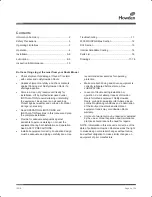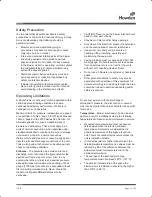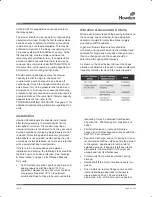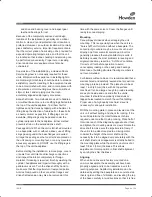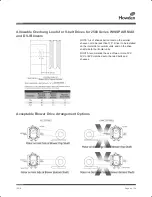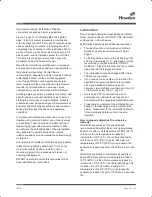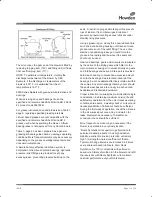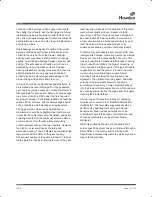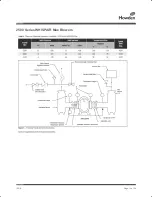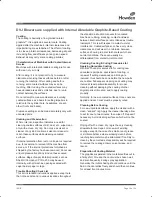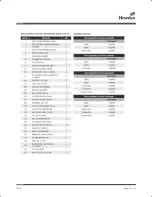
ISRB
2005 GEA 20260
Page 6 of 24
and drive end bearing cover and inspect gear
teeth and bearings for rust.
Because of the completely enclosed unit design,
location of the installation is generally not a critical
matter. A clean, dry and protected indoor location is
preferred. However, an outdoor location will normally
give satisfactory service. Important requirements are
that the correct grade of lubricating oil be provided for
expected operating temperatures, and that the unit
be located so that routine checking and servicing can
be performed conveniently. Proper care in locating
driver and accessory equipment must also be
considered.
Supervision of the installation by a Howden Roots
Service Engineer is not usually required for these
units. Workmen with experience in installing light to
medium weight machinery should be able to produce
satisfactory results. Handling of the equipment needs
to be accomplished with care, and in compliance with
safe practices. Unit mounting must be solid, without
strain or twist, and air piping must be clean,
accurately aligned and properly connected.
Bare-shaft Units: Two methods are used to handle a
unit without base. One is to use lifting lugs bolted into
the top of the unit headplates. Test them first for
tightness and fractures by tapping with a hammer. In
lifting, keep the direction of cable pull on these bolts
as nearly vertical as possible. If lifting lugs are not
available, lifting slings may be passed under the
cylinder adjacent to the headplates. Either method
prevents strain on the extended drive shaft.
Packaged Units: When the unit is furnished mounted
on a baseplate, with or without a driver, use of lifting
slings passing under the base flanges is required.
Arrange these slings so that no strains are placed on
the unit casing or mounting feet, or on any mounted
accessory equipment. DO NOT use the lifting lugs in
the top of the unit headplates.
Before starting the installation, remove plugs, covers
or seals from unit inlet and discharge connections
and inspect the interior completely for foreign
material. If cleaning is required, finish by washing the
cylinder, headplates and impeller thoroughly with a
petroleum solvent. Turn the drive shaft by hand to
make sure that the impellers turn freely at all points.
Anti-rust compound on the connection flanges and
drive shaft extension may also be removed at this
time with the same solvent. Cover the flanges until
ready to connect piping.
Mounting
Care will pay dividends when arranging the unit
mounting. This is especially true when the unit is a
“bare-shaft” unit furnished without a baseplate. The
convenient procedure may be to mount such a unit
directly on a floor or small concrete pad, but this
generally produces the least satisfactory results. It
definitely causes the most problems in leveling and
alignment and may result in a “Soft Foot” condition.
Correct soft foot before operation to avoid
unnecessary loading on the casing and bearings.
Direct use of building structural framing members is
not recommended.
For blowers without a base, it is recommended that a
well anchored and carefully leveled steel or cast iron
mounting plate be provided. The plate should be at
least 1 inch (25 mm) thick, with its top surface
machined fl at, and large enough to provide leveling
areas at one side and one end after the unit is
mounted. It should have properly sized studs or
tapped holes located to match the unit foot drilling.
Proper use of a high quality machinist’s level is
necessary for adequate installation.
With the mounting plate in place and leveled, set the
unit on it without bolting and check for rocking. If it is
not solid, determine the total thickness of shims
required under one foot to stop rocking. Place half of
this under each of the diagonally-opposite short feet,
and tighten the mounting studs or screws. Rotate the
drive shaft to make sure the impellers turn freely. If
the unit is to be direct coupled to a driving motor,
consider the height of the motor shaft and the
necessity for it to be aligned very accurately with the
unit shaft. Best unit arrangement is directly bolted to
the mounting plate while the driver is on shims of at
least 1/8 inch (3mm) thickness. This allows
adjustment of motor position in final shaft alignment
by varying the shim thickness.
Aligning
When unit and driver are factory mounted on a
common baseplate, the assembly will have been
properly aligned and is to be treated as a unit for
leveling purposes. Satisfactory installation can be
obtained by setting the baseplate on a concrete slab
that is rigid and free of vibration, and levelling the top
of the base carefully in two directions so that it is free
ISRB 2005 GEA 20260.indd 6
17/09/2015 12:53
Summary of Contents for Roots 2500 Series WHISPAIR MAX
Page 14: ...ISRB 2005 GEA 20260 Page 14 of 24 Troubleshooting Checklist...
Page 15: ...ISRB 2005 GEA 20260 Page 15 of 24 2500 Series WHISPAIR Max Blowers...
Page 20: ...ISRB 2005 GEA 20260 Page 20 of 24...
Page 21: ...ISRB 2005 GEA 20260 Page 21 of 24 Assembly of 2500 Series WHISPAIR Max Blower...
Page 22: ...ISRB 2005 GEA 20260 Page 22 of 24 Assembly of 2500 Series DVJ Blower...


